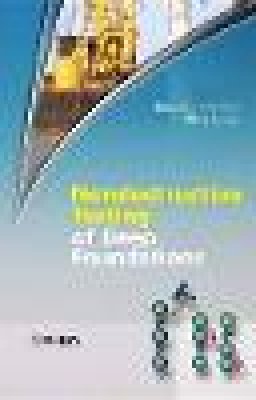BERNARD H. HERTLEIN, M.ASCE Bernard Hertlein started his professional career as a mechanical engineering student but soon realized that he had a natural affinity for electronics. After working professionally with automotive electronic systems and pursuing audio engineering as a hobby for several years, he migrated through audio engineering to instrumentation of civil engineering structures and finally to nondestructive testing. After joining Testconsult, the English subsidiary of the French National Center for Building and Civil Engineering Research (CEBTP), Mr Hertlein became deeply involved with the development of both the software and the hardware for several nondestructive test techniques for deep foundations that are now in common use worldwide. He worked on construction testing projects throughout Europe, HongKong, parts of North Africa and the United States, eventually settling in the United States, where he and Allen Davis introduced the Cross-hole Sonic-Logging technique, the Parallel-Seismic test and the Impulse-Response (Sonic-Mobility) test in the mid 1980s. In 1992, Mr Hertlein joined STS Consultants, based inVernon Hills, Illinois, where he has continued to design and build test equipment and research new applications for the test techniques that he had helped to introduce to the United States. Mr Hertlein is an active member of several key professional societies. At the time of writing this book, he is a member of the American Society of Civil Engineers, Chairman of the Nondestructive and In-place Testing Committee of the American Society for Testing and Materials (ASTM C9-64), Chairman of the Testing and Evaluation Committee of the Deep Foundations Institute, and Secretary of the Nondestructive Testing Committee of the American Concrete Institute (ACI 228). He also serves as a member of ACI Committee 336: Footings, Mats and Drilled Piers, ASTM Committee C9-47:Self-Consolidating Concrete, D18-11: Deep Foundations and G9-14: Corrosion of Reinforcing Steel. Mr Hertlein has written numerous conference papers and journal articles. He is a regular member of the faculty for the International Association of Foundation Drilling(ADSC-IAFD) Drilled Shaft Inspector’s School and a frequent lecturer at other educational seminars presented byACI International, ADSC regional chapters, the ASCE Geo-Institute and the Deep Foundations Institute. ALLEN G. DAVIS, PH.D., D.SC., PE Allen Davis qualified as a geologist and his first career was as prospector for De Beers Corporation in Central Africa. He then converted to Civil Engineering through Geotechnics, gaining his Ph.D. from Birmingham University, UK in that subject. He has had Academic, Research and Industrial experience in fairly equal proportions, including: Professor at the University of Birmingham, UK, for 10 years. Head of the Geotechnical and Highways Research Division, National Center for Building and Civil Engineering Research (CEBTP), Paris, France, for 8 years. Technical and Managing Director, Testconsult CEBTP (UK) for 8 years. He was one of the founding members of Testconsult in 1974. Principal Engineer, STS Consultants, Ltd and Manager for NDE, Madsen, Kneppers Associates, Chicago, Illinois and Salt Lake City, Utah, USA for 6 years. Senior Principal Engineer, Construction Technology Laboratories, Inc. (CTL), Skokie, Illinois, USA for the last 6 years. At the time of writing this book he was Manager of Nondestructive Evaluation at CTL in Skokie, Illinois. His special interests included vibration problems and realtime data acquisition from dynamic testing of concrete foundations and structures, and he was a member and past Chairman of Committee 228 (Nondestructive Testing of Concrete) of the American Concrete Institute and also a member ofASTMCommittee Nondestructive and In-place Testing. He has published over 80 technical articles and publications to date in the fields of Civil Engineering and Building, Transportation and Materials Resources. Eleven Ph.D. research students (seven in France, four in England) have graduated under his supervision, and he was awarded the degree of Doctor of Science by Birmingham University in 1980. His contributions to the concrete industry and to the work of the ACI were recognized at the October 2004 meeting of the ACI in San Francisco, where it was announced that he had been elected a Fellow of the Institute. Unfortunately ill-health had prevented him from going to San Francisco, and he passed away suddenly at his home a few hours after learning of the fellowship announcement. Rest in peace, old chum.

